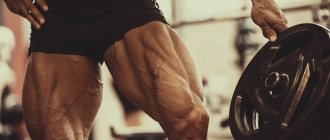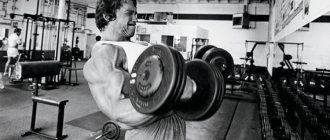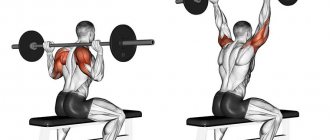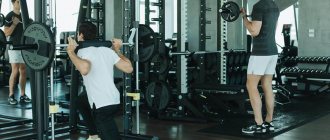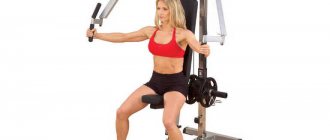How to force yourself to start training
Even after deciding to exercise, forcing yourself to exercise regularly is not easy. And little tricks will help novice athletes with this:
- Favorite sport. Much more enthusiasm will be generated by physical activity that brings pleasure. For some it’s aerobics, dancing or tai-bo, while others prefer exercise machines or crossfit.
- Good company. Going to the gym or fitness club with friends is more interesting and fun. In addition, you won’t be able to skip a workout again due to laziness.
- “Your” coach. The first classes are best conducted under the supervision of a professional who will develop an individual program, monitor the technique, motivate and encourage.
- Setting goals. Lose weight, get pumped up, tone up – the goal can be anything. It’s even better if it is visualized in the form of a photo of an athlete, a star, or at least a slender friend.
- Step-by-step training plan. Working according to a program where everything is written out is much easier and more effective than standing aimlessly in front of each exercise machine, wondering whether you need to exercise on it or not.
- Training uniform. Special clothing will not only solve the problem with air exchange and moisture release, but will also psychologically prepare you for classes.
- Public promise. Having told friends and acquaintances about the start of training, it will be difficult to “back down” and ignore their questions about sports achievements.
- First results. Studies have shown that after achieving minimal benefits from exercise, people are more enthusiastic about continuing their workouts.
- Entourage. We are talking not only about clothes, but also about a playlist with your favorite music or sports gadgets that can brighten up your stay in the gym.
- Reward system. For effective work in the gym or group, you can reward yourself with small “goodies” or less high-calorie things: shopping, cinema, going to an amusement park.
No matter how strange it may sound, sport is addictive, and many people, having started training, continue to do so for the rest of their lives.
When choosing a trainer, you need to find out his experience and specialized education. It is better if it is a higher specialized education, rather than a 2-week course. You need to understand well which person you can trust with your health.
Be sure to check out:
Exercises and programs for losing weight in the gym Circular training: basic rules of training for girls Effective program for men in the gym: tips for beginners The most effective complexes for working out the hips and buttocks
Gym training program for girls
Below are examples of workouts based on the area you need to work on and your goal.
Training program for girls for weight loss
To burn fat, it is recommended to do more repetitions using free weights. Cardio exercises are suitable for warming up your muscles. You can use this selection of exercises as a basis for your training, adding to it at your discretion:
- Pull-ups or lat pull-downs - to develop the back, shoulders, arms and upper body;
- dumbbell press on an inclined or horizontal bench - to develop the muscles of the arms, chest, and torso;
- twisting on an inclined or straight bench or lifting the legs with emphasis on the elbows - to work the abdominal muscles;
- squats with dumbbells, one leg on a bench - for the hips and buttocks;
- Romanian deadlift - for the back of the thighs, calves, back muscles and forearms.
You need to perform it 10–15 times per approach on each side. At the end of the session, be sure to stretch; it will make the body flexible and relax the muscles. A training program for girls in the gym for weight loss can be combined with exercises for muscle growth that are performed with heavy weights.
Buttocks and legs
To pump up this part of the body, the following exercises are suitable:
- leg press - performed on a special machine with an individually set weight;
- abduction of legs with weight - the leg clings to the handle of the block, after which the legs are swung to the side, back and forward;
- lunges - take dumbbells into your hands, after which you need to do deep lunges forward, backward and sideways.
Press and body
Not a single gym training program for girls is complete without abdominal exercises. Suitable for this:
- crunches on the simulator;
- lifting legs on the horizontal bar;
- leg lifting in TRX loops;
- leg lift with fitball.
It is recommended to perform the exercises at least 10–15 times in 2–3 approaches. In this case, the weight is taken so that the last times are difficult.
Back and arms
A beginner may underestimate the importance of training the back and arms, but a gym training program for girls must definitely include exercises for these parts of the body. When performing each of them, you need to feel how the body works and direct the effort correctly. To target these muscle groups:
- traction in the lower and upper blocks;
- pulling up;
- hyperextension;
- lifting arms with weights;
- Pullover on an incline bench in different variations.
Choosing a gym: rocking or fitness
To get a beautiful figure, you will have to work hard on your body. This is where beginners have the question of what to choose – a gym or a fitness club.
An accurate definition of the training goals will help you make the right choice. If an athlete wants to lose weight, tighten body contours, improve his endurance and performance, then he should pay attention to fitness classes. If your main goal is to build muscle mass, then welcome to the gym.
Each of these training locations has its own advantages and disadvantages.
Speaking about fitness, it is worth mentioning its advantages such as:
- accessibility (basic elements can be performed by almost anyone);
- versatility (group classes are suitable for most athletes);
- variety of programs (from strength training to express weight loss).
It is also worth mentioning that when training in a group, it is much more difficult to miss an appointment without a good reason.
Important! Speaking about the disadvantages, first of all it is worth mentioning the cost of the subscription. The second disadvantage is the tight schedule. The athlete will have to adapt to the majority. Another fly in the ointment is the limited enrollment in groups. You may not have time to sign up for the program you like.
People most often go to the gym to gain bulky muscles. Additionally, the cardiovascular system and endurance are strengthened. With a well-developed training plan, working out in the gym, you can lose weight.
The main advantages of the hall are:
- a variety of exercise machines that can load almost all muscle groups;
- weight of additional sports equipment;
- convenient visiting schedule;
- lower cost of a subscription compared to a fitness club;
- individual lesson plan with the possibility of its subsequent adjustment;
- clearer focus on results.
There are some downsides here too:
- lack of experience in using equipment and exercise equipment for beginners (first lessons only with a coach or instructor);
- "full house" in the evening after work.
Each athlete chooses where and how to exercise, but beginner athletes should still consult with experts.
How to exercise on exercise machines
How to choose which machines to exercise on
Before you start training, you need to decide on their purpose. Usually people go to the gym to lose weight, gain muscle mass, get better definition, or simply keep their body in shape. Based on these goals, choose exercise equipment and training regimen.
Exercise machines are divided into two groups: cardio and strength equipment. Cardio machines help you lose excess weight much more effectively and quickly, and strength machines help you build muscle mass instead.
In addition to the listed functions, cardio equipment improves the functioning of the cardiovascular system, pumps up the legs and buttocks, and also develops endurance. Weight loss occurs due to the acceleration of metabolism, and the more muscles are involved in work, the sooner you will lose excess weight.
Strength trainers have a targeted effect, they work on a specific muscle group, while other muscles at this time are either at rest or are involved, but to a lesser extent. They are responsible for increasing muscle mass. They also help develop endurance, improve coordination and flexibility.
The ideal workout is alternating between cardio and strength training, with an emphasis on those machines that will help you achieve your goal. If you want to lose weight, don’t be afraid of weight training equipment; it’s a myth that you will gain mountains of muscle after it. Cardio training will lead to weight loss, but your figure will also be far from ideal due to the lack of a muscle corset that forms a beautiful body.
How to exercise correctly in the gym
If you are a beginner, you should start with a light load, 3 classes per week will be enough. This way, you won’t lose your enthusiasm and won’t get tired of the monotony. As you get used to it, go to 5 classes. Some may even start going to the gym 6 days a week, and even every day, ignoring holidays and weekends (although this regime is more often chosen by professional athletes).
Correct, effective training takes about an hour and a half. For each simulator, 15–20 repetitions and 3–4 approaches are allotted. The rest can be no more than a minute; this time is enough to rest a little and not relax. Also, beginners are often advised not to reduce the number of repetitions and approaches; if you are given 12 repetitions in 3 approaches, do it. If you find it difficult, keep the weight to a minimum, but do not reduce the number of repetitions.
You already understand that you need to do both cardio and strength training. You should think about how much time to spend on each, based on your goals. If you want to increase muscle mass, use cardio equipment in the form of a 10-15 minute warm-up and do strength training. At the same time, experienced athletes have their own system, which is relevant when they have already gained weight. They dedicate one day to training a specific muscle group (for example, Monday - chest, Tuesday - biceps, Wednesday - abs, etc.)
If you're looking to lose weight, go to the cardio zone, warm up for 15 minutes, then move to the strength zone for an hour.
Then go back to the cardio training area to burn calories. This will be the most optimal training option, where you will simultaneously burn fat and build muscle in its place. In the end, it is worth noting that training on simulators is, first of all, not a weekly measure to lose the kilograms gained over the holidays. From now on, this is your way of life (if you really want to achieve good, long-lasting results). Therefore, you should not believe that without proper nutrition and giving up bad habits, something will change in a positive direction only through training.
How to organize and prepare for your first training session
The preparatory stage is no less important than the first few workouts. It allows you to tune in psychologically and develop self-confidence and understanding of the need for physical education.
What you need on your first day at the gym
Getting ready for the gym for the first time is similar to getting ready for vacation. Just as in the latter case, it is better to make a list of necessary things in advance. The athlete will need:
- Sports backpack or bag.
- Sneakers.
- Shower shoes (flip-flops).
- Towel and soap accessories.
- Clothing for classes.
- Bottle of water.
You can also take a fitness bracelet with you that will measure your heart rate. Those working with a barbell will need gloves to prevent the appearance of calluses.
Don't forget about warming up
One of the most common mistakes beginners make is ignoring the warm-up, but this is a very important stage of training.
Denis Semenikhin
TV presenter, video blogger, author of books on fitness
First of all, beginners should not forget about the importance of warming up, which starts the work of the cardiovascular system. If control is possible, you need to ensure that the pulse at this stage does not exceed 60% of its maximum.
Warm-up is necessary for:
- stretching muscles and improving joint elasticity;
- reducing the risk of injury;
- increasing training efficiency;
- acceleration of metabolism (due to increased heart rate);
- preparing the body for further stress.
A full warm-up takes from 5 to 15 minutes and includes muscle exercises:
- neck;
- shoulder girdle;
- breasts;
- backs;
- torso;
- lower back;
- legs;
- calves and ankles.
In this case, areas that have been injured should be given more attention. The warm-up can also include exercise on cardio equipment: rowing machine, elliptical machine, treadmill.
Checklist: how to prepare and what to consider for a beginner
Discover this content for FREE! image/svg+xml
Your likes and reposts really help our project!
Share Tweet
How to choose suitable loads so as not to harm your health
A competent training plan includes not only a list of exercises and the frequency of visiting the gym, but also load distribution. This should be done by a professional.
Even in the process of drawing up the program, all initial anthropometric data and information about the presence of injuries, diseases and daily routine are taken from the athlete. Only after this is the optimal plan selected, which includes gradually progressive loads.
Often the first type of training that is recommended for a beginner is the full body. This type of training allows you to work all major muscle groups in one session. You can work with a full body 2-3 times a week, which is quite enough for an inexperienced athlete.
Important! When compiling a list of exercises, age and the presence of diseases must be taken into account. Thus, a 16-year-old teenager will not be allowed to do deadlifts or perform bench presses with heavy weights; on the other hand, leg exercises will be removed from the program for people with varicose veins.
Athletes will also have to reduce their loads after a long break from training. Of course, muscle memory will allow them to progress faster and change weights, but they won’t be able to immediately return to their previous performance.
How to choose a regime: how many times to go to the gym per week
Many beginning athletes think that the more time they spend in the gym, the faster they will achieve results. However, in reality everything is different.
It all depends on the goals. To lose weight, you need to focus on cardio training and go to the gym 3-4 times a week. In this case, one of the workouts can be replaced with a morning jog of several kilometers.
But those who want to swing properly should remember such a phenomenon as the restoration of muscle tissue. It is during power loads that the muscles receive micro-tears, which, when restored, thicken the muscle fibers, thus producing muscle growth. After each session, any muscle group needs time to rest and regenerate. For professionals it is 48-55 hours, for beginners - at least 72. Thus, the optimal training regime for beginner athletes is 2-3 times a week.
Adjust your diet
The training plan necessarily includes the development of a diet. To lose weight, girls must reduce the amount of fast carbohydrates in their diet, increase the amount of fluid they consume, and add vitamins.
When pumping up muscle mass, you need to increase the amount of protein, both animal and vegetable.
Interesting: you can drink water with magnesium to reduce appetite.
Gym lesson plan. Where to begin?
| Author: | Denis Chernigov(homka) |
| Published: | 09.01.2012 |
| Key words: index ..." | Gym |
Arriving at the gym, many do not know where to start exercising. There is either no coach, or for some reason he does not approach you, or at the start he asks for money, but it is not always available.
There is so much that is incomprehensible—unfamiliar…
This article will be devoted to the first independent training of a single “carcass” in a “simulator”.
The first, initial and most important thing is warm-up. It cannot be neglected and done in a “get away” manner.
The essence of warming up is to prepare the body for work and avoid injury.
Joints, ligaments, muscles need to be warmed up and made flexible.
Another important point is that warming up in itself is an integral part of the workout! Try it - you will see that after the warm-up below, it seems that you have already worked out!
So, a lot of text. Go!
Let's begin. As usual in Russia, from the “ass”, i.e. We read about the warm-up with a description in Appendix 1. The smart ones will read and learn, and the fools will give work for the trampolines.
Let's move on to the training plan
. At the initial stage (1-3 weeks), if you do not run away from the gym, which is quite likely, it will be enough.
There are slight differences in exercises for boys and girls, as will be indicated in the text.
This plan is universal. And for plump, and for slim, and for boys, and for girls.
If you honestly work on it for 3 weeks, the result will be noticeable. The body will tighten up, a pleasant feeling of muscles will appear (they are still there!), and the desire to continue exercising will appear!
Just don't expect miracles - this is not plastic surgery.
Conventionally, we divide the carcass into 3 parts: bottom-top-middle
.
Today we start from the bottom. Explanations along the way and at the end of the text.
Bottom of the carcass
- 1) Leg press in the machine. This simulator is available in almost any gym. It looks different. We have simple weights with free weights (barbell weights), we have block weights, which are very convenient for girls - you don’t need to carry the weights, just move the pin on the weight block. The same applies to the other shells listed below.
Execution technique. Place your feet on the platform shoulder-width apart. Socks are spread out to the sides by about 30 degrees. We squeeze the platform to the end. Then ( important!), spreading your knees to the sides as much as possible, lower the platform as low as possible. Etc., until the required number of repetitions, more on that below.
- 2) We are learning a new term - “superset”. These are two exercises that are performed one after the other without rest. You completed two exercises and rested. Then again. A) Boys
- 2nd exercise – leg bending.
- B) Girls
- 2nd exercise – leg bending.
- 1) Seated press in the simulator. Extend your arms - exhale, bend them - inhale. Movement to full amplitude.
- 2) Pull the block behind the head. We simply pull it smoothly until it touches the neck and also smoothly release it back.
- 3) Pullover. A dumbbell or disc from a barbell in your paws in this position. For girls 5-7 kg. Boys 10-15 kg. At the start, we take the projectile with both hands and squeeze it up halfway. So that your hands make a “ring”. As in the photo. In this position we lower them behind the head. The elbows are motionless. Movement is only in the shoulder joint. Down behind your head as much as possible. Then - the starting position. And further.
- 1) Hyperextension. This is such a difficult word. The machines come in other, more ergonomic designs, but this is what we have. No less functional. It seems like a simple movement, but contains a number of nuances. Before starting, you need to squeeze your shoulder blades together and raise your head up. Then everything is simple - down and up at a moderate pace. Exhale at the top. 15-20 repetitions. It turns out less - no big deal.
- 2) Press. Carcass bending. Exactly as in the photo and without any simulators. The shoulder blades lift off the floor by 3-5cm. The lower back is pressed to the floor. We curl up into a ball, like a hedgehog.
- The first lesson, do everything according to the 1st approach. An approach is performing the first exercise 10-15 times. Completed it - rested for 1-2 minutes - performed it again (this is the 2nd approach). Under no circumstances should you complete the entire training plan and start over. This is completely wrong.
- The first lesson - one approach to all exercises, the second lesson - one or two approaches, the third - two approaches are required, the third - optional, for those exercises that you like. Second week – all 2-3 approaches. Third week – all 3 approaches.
- The number of repetitions per approach is 10-15 times. If 15 is easy, increase the weight. If you can’t get 10, reduce it. The last repetitions must be given with obvious difficulty, otherwise there will be no
- Rest between sets and exercises 1-2 minutes. At the initial stage, rest a lot and for a long time. Remember that the process of refining your “carcass” does not occur during training, but during rest and sleep between classes. Therefore, there is never too much rest, and the main thing in this corps de ballet is regularity! Not the intensity of an individual workout.
- You need to exercise 3 times a week. In one day. For the muscles to recover. It is during the process of rest that the “miracles” of restoring the “carcass” happen. Classic: Mon-Wed-Fri. Tue, Thu. – recovery time. Sat, Sun. - Same. Next is the next weekly cycle.
- You can start with any “block” of exercises you like: bottom, middle part or top. The main thing is that you don’t need to swap exercises! “Blocks” are necessary.
- No sudden movements. Everything is smooth and neat. We raise it one-two, one-two-three we lower it.
- Fill the pauses between exercises with slow, gentle stretches.
- 1) Clenching your fingers into fists, not imitation (this applies to all warm-up exercises!!!), namely clenching. With obvious effort! This applies primarily to lady fingers.
- 2) Rotation with cams. The radius described by the cam is maximum!
- 3) Rotation in the elbow joints. The elbow is firmly fixed. The hand is clenched into a fist. The cam with the elbow describes the maximum radius, while rotating as close as possible to the body.
- 4) Swing with straight arms at the shoulder joints. Maximum radius. Gradually increase the swing speed.
- 5) Head tilts:
- A) Back and forth. B) Left-right.
- 6) Rotation of the pelvis. Feet together. Knees bent. The head is in place. The radius described by the pelvis is maximum.
- 7) Knee rotation. Knees bent, back straight. The palm tightly hugs the kneecap.
 Leg kick. A) Left-right
Leg kick. A) Left-right - B) Back and forth.
- Before or after warming up, you can do 5-10 minutes. exercise bike or treadmill. A jump rope is also good.
- A little self-stretching after warming up won't hurt either!
| Start |
. Superset leg flexion-extension on the simulator. 1st exercise – leg extension.
| Start |
| Initial phase |
. Superset of lunges and leg curls on a machine.
- 1st exercise – lunges.
| Start |
| Initial phase |
Top of the carcass
Start - slowly lower back - finish. It's simple.
| Hold the dumbbell this way at the start |
Middle part of the carcass
All. This will be enough for the first 3 weeks. If you’re not tired, continue walking around the gym and just try unfamiliar exercise machines!
Now the main thing. How to work according to this plan.
. The press is an exception. It must be done “to the limit.”
Well, that's all for starters. Don't forget about the warm-up in Appendix 1! Health and good luck to everyone!
Appendix 1 Warm-up
Everything described below is done 15-20 times.
I will be grateful for discussion and any criticism.
Sincerely, Denis Chernigov. Master of Sports of Russia in powerlifting, Champion of Russia in bench press. Trainer with 19 years of experience in powerlifting, athleticism and rehabilitation physical education.
Special thanks for editing to the personal trainer of the gym, MSMK Evgenia Sukhova,
And also, to photo models: fitness and aqua aerobics instructor of the Aquastar club, MS Rossi for sports aerobics, Yulia Voitovich, and mountaineering veteran, well-known forum member Yuri Mikhailichenko.
Do you need a trainer?
The question of the need for a coach often faces novice athletes. Many believe that this is a waste of money, since the instructor available in each gym is able to help understand the operation of the simulators and give general recommendations.
And yet the functions of an individual trainer are very important:
- He will help you create a training program.
- Explains the rules for using exercise equipment.
- Monitors the correct technique for performing the elements.
- If necessary, will make adjustments to the program.
Important! It is difficult for beginners to understand how correctly they perform this or that exercise, but the result directly depends on the technique.
Proper nutrition
A weight loss program in the gym includes not only training, but also a proper diet. But even if the goal of playing sports is not to lose weight, you should still eat a full and balanced diet so that the body receives the necessary energy to build muscle mass. At the same time, it is not recommended to adhere to a diet, since a decrease in food consumption very often leads to protein burning. Protein deficiency, in turn, leads to stretch marks, wasting muscle tissue and decreased skin elasticity. An athlete's daily diet must contain proteins and carbohydrates. It is useful to eat lean meat, cereals (rice, buckwheat and oatmeal), fish, nuts, fruits and honey. But it’s better to completely forget about baked goods, soda and alcoholic drinks.
After strength training, it is best to eat protein foods. For example, after an evening workout at the gym, vegetables and chicken breast are great for dinner. This diet helps not only burn fat, but also maintain muscle elasticity.
As a rule, the gym for girls is one of the ways to lose weight. Therefore, on training days, it is recommended to limit the consumption of animal fats and exclude fatty, salty and spicy foods from the diet. Therefore, in order to achieve the results you need, you need to combine the best gyms with the right nutritious diet.
How to avoid mistakes at the very beginning of training
Both beginning athletes and professionals can make mistakes. The difference is that the first group has many more of them. The general thing is that they all affect the effectiveness of training.
Beginners most often “sin” the following:
- ignore program development;
- forgetting about the meal plan;
- neglect rest between classes;
- perform exercises incorrectly;
- do not study the rules for using simulators;
- They ignore breathing techniques, warm-up and cool-down.
As a result, even after a month of intensive training and visiting the gym 4-5 times a week, there is no visible result. The beginner becomes disappointed and eventually reduces his sports activity to “nothing.”
HOW TO SURVIVE AS A BEGINNER OR WHERE TO START TRAINING IN A FITNESS CLUB
8 key rules that will help you start effective training in the gym without mistakes
At the very beginning, it is important for you to understand: - The structure of any workout: warm-up, workout, cool-down;
— Training intensity: how many times a week to train and for how long; — How to choose exercises, how many of them should be in one workout and how not to get confused in approaches and repetitions; — How to understand the simulators; — What to do if you need results in a specific area: beautiful abs, a beautiful butt, a narrow waist, or you want to lose weight “only in your legs.” The main thing you need to understand is that there are some general rules that are important to adhere to when training at the start, but in general, each training program is individual and tailored to you and your task, based on your current training, health status, etc.
We answer frequently asked questions and provide rules based on which you can start training and adjust them along the way to suit yourself or with the help of a trainer.
Go.
1.What should be the structure of the training?
Just remember:
Warm up -> Workout -> Cool down.
Warm-up is important.
Warm-up is about 10 minutes (total) of full-body stretching and aerobic (movement) exercises at the very beginning of your workout.
Warm-up exercises:
– easy jogging on the track; – jumping rope; – light exercises for the muscles of the legs, arms and torso (push-ups, squats, etc.); – exercises to increase the flexibility of the arms, legs and spine (rotational movements, bending, etc.)
Warm-up stretches and tones the muscles, develops ligaments and joints, and prepares them for heavy loads. Speeds up metabolism, fills muscles with blood and increases cardiovascular activity.
Warming up prevents injuries and increases the effectiveness of your workout.
Cooling down is very important.
Cooling down also prevents injury and reduces muscle soreness after exercise.
During exercise, lactic acid accumulates in the muscles. This is manifested by muscle pain (krepatura).
Cooling down helps remove some of the lactic acid from the muscles. This means that your muscles won't hurt as much as if you didn't cool down.
Cooling down helps lower your heart rate and “calm” your body after a workout.
Cool-down exercises:
– light jogging, which gradually turns into walking; – stretching exercises.
We'll talk more about the training itself below.
2.How many times a week should I train?
Minimum 2 workouts. This is the minimum volume that will help you feel and see changes in your body.
It's minimum.
Optimally, this is 3-4 workouts per week. This way you will significantly speed up the result.
You need to work 6 main muscle groups:
Legs Arms Shoulders Chest Back Core (abs)
In each workout, you can work all muscle groups or separate the upper and lower groups on different training days.
When is it better to train all muscle groups on one day, and when to separate the upper and lower groups on different training days?
If you haven’t trained in the gym before , you must do full-body workouts (all muscle groups) at every workout.
It is better to take a 1-2 day break between workouts.
This is a science-based approach.
In the days between workouts, muscle protein is synthesized, muscles are restored, muscles are strengthened and built, and excess fat is burned.
This training format will be enough to get noticeable results and feel an improvement in your overall well-being in just a couple of weeks.
You need to switch to separate training when training for the whole body ceases to give results visible in the mirror and you feel that this load is not enough for you, and the muscles do not grow and excess fat is not burned (on average, this is a couple of months of training).
This means that the muscles need more load - either by doing the exercises longer or with more weight.
But within one workout there may not be enough time to work out all muscle groups, or you will simply get tired from heavy weights on the whole body.
With split workouts, you train your upper and lower body muscles on separate days.
This way you load your muscles more than during full body workouts, and again you begin to see results.
If you decide to train 4 times a week, you can plan your training like this:
Monday - bottom. Tuesday is the top. Rest 1 day. Thursday - bottom. Friday is the top.
And you will have 2 more days to recover well for the next workout.
3.How long should the workout last?
Optimal - 1–1.5 hours, maximum - 2 hours. If you can train longer, it means you’ve been slacking.
This is the time during which metabolism accelerates and fat burning processes are launched when losing weight, and the muscles have enough load to begin to strengthen and gain weight.
4.How to choose exercises and how many of them should be in one workout?
If you do full body workouts, then choose exercises for the whole body.
If training is for the top or bottom, then the exercises are for the top or bottom.
What exercises exactly?
Follow this link
you can download the exercise program, which is designed to suit the capabilities of our gym. We have all the necessary equipment to perform these exercises.
The number of exercises, approaches, repetitions is indicated in the program .
*if you cannot perform the required number of repetitions of an exercise with your own weight, for example, push-ups, then do as many push-ups as you can. Over time, you will reach the required amount.
If you train on your own, simply print out this program and come to the gym with the sheets.
This way you won’t get confused and confused about what to do and in what order.
If you train with a personal trainer, he will be with you throughout the entire workout.
He will create a program for you. He will tell you what exercises to do, how many approaches, repetitions, rest between exercises and approaches, and will control the execution technique to speed up your results.
5.How much rest between exercises and approaches?
Huge scientific works are written on this topic.
But you can use this rest time as a basis.
To rest between sets of the same exercise:
If you do 1-3 reps (with heavy weights) in one set: rest for 3-5 minutes. 4–7 reps: 2–3 minutes 8–12 reps: 1–2 minutes 13 or more reps: 1 minute
To rest between different exercises:
You should start the next exercise rested.
Usually this is 2–3 minutes. If you feel that you have not yet recovered, you can take a couple more minutes of break.
6.How to determine the optimal weight for exercise?
Any exercise consists of a “warm-up” approach and “main” approaches.
The warm-up approach is performed with the minimum weight, or with your own body weight. Even professionals do this.
This approach is needed to stretch the muscles and prepare them for the load.
As a rule, this is 16–20 repetitions.
After the warm-up, 3-4 main approaches with working weight follow.
As a result, each exercise consists of 4–5 approaches. 1 warm-up and 3-4 main ones.
There are 2 simple criteria that will help you roughly determine your starting working weight:
1. The weight should be such that you can do 3 sets of 10-12 repetitions of the exercise with correct technique. 2. The last 2-3 repetitions should be difficult.
This means the weight is appropriate.
How exactly to define it?
Feels like it.
Take the weight that you think you can do 10-12 times with minimal effort (10-15-20 kg). And do 3 approaches.
If during the first set you realize that this weight is not enough, and you can do 2 more sets without much effort, increase the weight, but not too much.
You shouldn’t do many approaches and try to determine the final working weight in one workout.
Firstly, you will get tired and the weight will be inaccurate, and secondly, you still need to have time to do exercises for other muscle groups.
Remember (or better yet, write down) the weight you worked with in this workout, and reduce or increase it in the next workout to the required criteria.
7. I don’t quite understand what kind of exercise equipment I need and how to work with them.
We could give a description of the simulators and show how they work, but this is boring. With practice, you will master everything faster.
In the program that you could download here, we selected exercises for our simulators.
If you train on your own, without a personal trainer, then come to the gym with her, go up to any trainer, point your finger at an exercise from the program and ask: “Where is this machine and how to work with it?”
All coaches are focused on your results.
8.I see. What if I just want beautiful abs, a firm butt, or “lose weight in my legs”?
All this is real.
But.
Don't be fooled by beautiful promises. Unfortunately, it is impossible to lose weight or gain weight or strengthen something only in a specific place.
This is how the body works. Yes. We are also indignant



